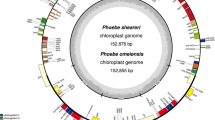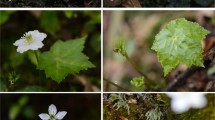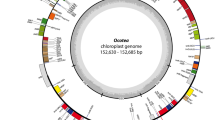Abstract
Restriction site mapping of chloroplast DNA from 31 species representing 26 genera of theRanunculaceae was performed using eleven restriction endonucleases. The chloroplast genome varies in length from approximately 152 to 160 kb. Length variants are frequent in theRanunculaceae and range from usually less than 300 bp to rarely 1.5 kb. The inverted repeat is extended into the large single copy (LSC) region by 4–4.5 kb inAnemone, Clematis, Clematopsis, Hepatica, Knowltonia, andPulsatilla. Several inversions are present in the LSC-region of the cpDNA in all these genera and inAdonis. The frequency of restriction site mutations varies within the chloroplast genome in theRanunculaceae between 4 and 32 mutations per kilobase, and is lowest in the inverted repeat and the regions containing the ATPase-genes and the genespsaA, psaB, psbA, rpoB, andrbcL. A total of 547 phylogenetically informative restriction sites was utilized in cladistic analyses of the family using Wagner, Dollo, and weighted parsimony. These three parsimony analyses result in different tree topologies. Four, six, and one equally most parsimonious trees were obtained with Wagner, Dollo, and weighted parsimony, respectively. The amount of support for the monophyletic groups was evaluated using bootstrapping and decay analysis. All three parsimony methods suggest thatHydrastis is the sister group to the remainder of theRanunculaceae, and that theAnemone-Clematis group, which shares several derived cpDNA rearrangements, is monophyletic. Only a few of the traditional groups in theRanunculaceae are supported by cpDNA restriction side data. Only Dollo parsimony provides support for the hypothesis thatThalictroideae andRanunculoideae are monophyletic.
Similar content being viewed by others
References
Albert, V. A., Mishler, B. D., Chase, M. W., 1992: Character-state weighting for restriction site data in phylogenetic reconstruction, with an example from chloroplast DNA. — InSoltis, P., Soltis, D. E., Doyle, J. J., (Eds): Molecular systematics of plants, pp. 369–403. — New York: Chapman & Hall.
Bremer, B., Jansen, R. K., 1991: Comparative restriction site mapping of chloroplast DNA implies new phylogenetic relationships withinRubiaceae. — Amer. J. Bot.78: 198–213.
Bremer, K., 1988: The limits of amino acid sequence data in angiosperm phylogenetic reconstruction. — Evolution42: 795–803.
Cronquist, A., 1981: An integrated system of classification of flowering plants. — New York: Columbia University Press.
Dahlgren, G., 1989: The last dahlgrenogram. System of classification of the dicotyledons. — In The Davis and Hedge Festschrift, pp. 249–260. — Edinburgh: Edinburgh University Press.
Dahlgren, R., 1983: General aspects of angiosperm evolution and macrosystematics. — Nordic J. Bot.3: 119–149.
DeBry, R. W., Slade, N. A., 1985: Cladistic analysis of restriction endonuclease cleavage maps within a maximum-likelihood framework. — Syst. Zool.34: 21–34.
De Candolle, A. P., 1824: Prodromus systematis naturalis regni vegetabilis 1. — Paris.
Donoghue, M. J., Olmstead, R. G., Smith, J. F., Palmer, J. D., 1992: Phylogenetic relationships ofDipsacales based onrbc L sequences. — Ann. Missouri Bot. Gard.79: 333–345.
Downie, S. R., Palmer, J. D., 1992: Use of chloroplast DNA rearrangements in reconstructing plant phylogeny. — InSoltis, P. S., Soltis, D. E., Doyle, J. J., (Eds): Molecular systematics of plants, pp. 14–35. — New York: Chapman & Hall.
Doyle, J. J., Doyle, J. L., 1987: A rapid DNA isolation procedure for small quantities of fresh leaf tissue. — Phytochem. Bull.19: 11–15.
Farris, J. S., 1970: Methods for comparing Wagner trees. — Syst. Zool.19: 83–92.
, 1977: Phylogenetic analysis under Dollo's law. — Syst. Zool.26: 77–88.
, 1989: The retention index and the rescaled consistency index. — Cladistics5: 417–419.
Felsenstein, J., 1985: Confidence limits on phylogenies an approach using the bootstrap. — Evolution39: 783–791.
Gregory, W. C., 1941: Phylogenetic and cytological studies in theRanunculaceae Juss. — Trans. Amer. Phil. Soc., n.s.,31: 443–521.
Grund, C., Gilroy, J., Gleaves, T., Jensen, U., Boulter, D., 1981: Systematic relationships of theRanunculaceae based on amino acid sequence data. — Phytochemistry20: 1559–1565.
Hegnauer, R., 1964: Chemotaxonomie der Pflanzen 3.Dicotyledoneae: Acanthaceae-Cyrillaceae. — Stuttgart, Basel: Birkhäuser.
, 1973: Chemotaxonomie der Pflanzen 6.Dicotyledoneae: Rafflesiaceae-Zygophyllaceae. — Stuttgart, Basel: Birkhäuser.
Hillis, D. M., Dixon, M. T., 1989: Vertebrate phylogeny: evidence from 28S ribosomal DNA sequences. — InFernholm, B., Bremer, K., Jornvall, H., (Eds): The hierarchy of life, Nobel Symposium 70, pp. 355–367. — Amsterdam: Elsevier.
Holsinger, K. E., Jansen, R. K., 1993: Phylogenetic analysis of restriction site data. — Meth. Enzymol. (in press).
Hoot, S. B., 1991: Phylogeny of theRanunculaceae based on epidermal microcharacters and macromorphology. — Syst. Bot.16: 741–755.
Janchen, E., 1949: Die systematische Gliederung der Ranunculaceen und Berberidaceen. — Denkschr. Akad. Wiss. Wien, Math.-naturwiss. Kl.,108: 1–82.
Jansen, R. K., Palmer, J. D., 1988: Phylogenetic implications of chloroplast DNA restriction site variation in theMutisieae (Asteraceae). — Amer. J. Bot.75: 753–766.
, 1990: Phylogenetic analysis of chloroplast DNA restriction site data at higher taxonomic levels: an example from theAsteraceae. — Evolution44: 2089–2099.
, 1991: Phylogeny and character evolution in theAsteraceae based on chloroplast DNA restriction site mapping. — Syst. Bot.16: 98–115.
,, 1992: Chloroplast DNA variation in theAsteraceae: phylogenetic and evolutionary implications. — InSoltis, P. S., Soltis, D. E., Doyle, J. J., (Eds): Molecular systematics of plants, pp. 252–279. — New York: Chapman & Hall.
Jensen, U., 1966: Die Verwandtschaftsverhältnisse innerhalb derRanunculaceae aus serologischer Sicht. — Ber. Deutsch. Bot. Ges.79: 407–412.
, 1968: Serologische Beiträge zur Systematik derRanunculaceae. — Bot. Jahrb.88: 269–310.
Johansson, J. T., Jansen, R. K., 1991: Chloroplast DNA variation among five species ofRanunculaceae: structure, sequence divergence, and phylogenetic relationships. — Pl. Syst. Evol.178: 9–25.
Kellogg, E. A., 1992: Tools for studying the chloroplast genome in theTriticeae (Gramineae): an Eco RI map, a diagnostic deletion, and support forBromus as an outgroup. — Amer. J. Bot.79: 186–197.
Kim, K.-J., Turner, B. L., Jansen, R. K., 1992: Phylogenetic and evolutionary implications of interspecific chloroplast DNA variation inKrigia (Asteraceae-Lactuceae). — Syst. Bot.17: 449–469.
Kumazawa, M., 1930: Morphology and biology ofGlaucidium palmatum Sib. etZucc. with notes of affinities to the allied generaHydrastis, Podophyllum, andDiphylleia. — J. Fac. Sci. Univ. Tokyo, Sect 3, Bot.,2: 345–380.
, 1938: Systematic and phylogenetic consideration of theRanunculaceae andBerberidaceae. — Bot. Mag. Tokyo52: 9–15.
Langlet, O. F. I., 1927: Beiträge zur Zytologie der Ranunculazeen. — Svensk Bot. Tidskr.21: 1–17.
, 1928: Einige Beobachtungen über die Zytologie der Berberidazeen. — Svensk Bot. Tidskr.22: 169–184.
, 1932: Über Chromosomenverhältnisse und Systematik derRanunculaceae. — Svensk Bot. Tidskr.26: 381–400.
Leppik, E. E., 1964: Floral evolution inRanunculaceae. — Iowa State Coll. Sci.39: 1–101.
Loconte, H., Estes, J. R., 1989: Phylogenetic systematics ofBerberidaceae andRanunculales (Magnoliidae). — Syst. Bot.14: 565–579.
Lotsy, J. P., 1911: Vorträge über botanische Stammgeschichte III (1). — Jena.
Maddison, D. R., 1991: The discovery and importance of multiple islands of most-parsimonious trees. — Syst. Zool.40: 315–328.
Olmstead, R. G., Palmer, J. D., 1992: A chloroplast DNA phylogeny of theSolanaceae: subfamilial relationships and character evolution. — Ann. Missouri Bot. Gard.79: 346–360.
, 1990: Chloroplast DNA and phylogenetic studies in theAsteridae. — InKawano, S., (Ed.): Biological approaches and evolutionary trends in plants, pp. 119–134. — New York: Academic Press.
Palmer, J. D., 1986: Isolation and structural analysis of chloroplast DNA. — Meth. Enzymol.118: 167–186.
, 1991: Plastid chromosomes: structure and evolution. — InBogorad, L., Vasil, I. K., (Eds): Cell culture and somatic cell genetics in plants, vol. 7, the molecular biology of plastids, pp. 5–53. — New York: Academic Press.
, 1988: Chloroplast DNA variation and plant phylogeny. — Ann. Missouri Bot. Gard.75: 1180–1206.
Prantl, K., 1888: Beiträge zur Morphologie und Systematik der Ranunculaceen. — Bot. Jahrb.9: 225–273.
, 1891:Ranunculaceae. — InEngler, A., Prantl, K., (Eds): Die natürlichen Pflanzenfamilien3(2), 43–66. — Leipzig: Engelmann.
Ranker, T. A., Soltis, D. E., Soltis, P. S., Gilmartin, A. J., 1990: Subfamilial phylogenetic relationships of theBromeliaceae: evidence from chloroplast DNA restriction site variation. — Syst. Bot.15: 425–434.
Santisuk, T., 1979: A palynological study of the tribeRanunculeae. — Opera Bot.48: 1–74.
Shinozaki, K., Ohme, M., Tanaka, M., Waksugi, T., Hayashida, N., Matsubayashi, T., Zaita, N., Chunwongse, J., Obokata, J., Yamaguchi-Shinozaki, K., Ohto, C., Torazawa, K., Meng, B. Y., Sugita, M., Deno, H., Kamogashira, T., Yamada, K., Kusuda, T., Takaiwa, F., Kato, A., Tohdoh, N., Shimada, H., Sugiura, M., 1986: The complete nucleotide sequence of the tobacco chloroplast genome: its gene organization and expression. — EMBO J.5: 2043–2049.
Soreng, R. J., Davis, J. I., Doyle, J. J., 1990: A phylogenetic analysis of chloroplast DNA restriction site variation inPoaceae subfam.Pooideae. — Pl. Syst. Evol.172: 83–97.
Sugiura, M., 1987: Structure and function of the tobacco chloroplast genome. — Bot. Mag. Tokyo100: 407–436.
, 1989: The chloroplast chromosomes in land plants. — Ann. Rev. Cell Biol.5: 51–70.
, 1986: Clone bank of the tobacco (Nicotiana tabacum) chloroplast genome as a set of overlapping restriction endonuclease fragments: mapping of eleven ribosomal protein genes. — Pl. Sci.44: 211–216.
Swofford, D. L., 1990: PAUP. Phylogenetic analysis using parsimony, version 3.0r for Macintosh. Computer package. — Champaign, Illinois: Illinois Nat. Hist. survey.
, 1990: Phylogeny reconstruction. — InHillis, D. M., Moritz, C., (Eds): Molecular systematics, pp. 411–501. — Sunderland, Massachusetts: Sinauer.
Sytsma, K. J., Smith, J. F., 1988: DNA and morphology: comparisons in theOnagraceae. — Ann. Missouri Bot. Gard.75: 1217–1237.
Takhtajan, A., 1986: Floristic regions of the world. — Berkeley: University of California Press.
Tamura, M., 1963–1968: Morphology, ecology, and phylogeny of theRanunculaceae I–VIII. — Sci. Rep.11 (1963): 115–126;12 (1963): 141–156;13 (1964): 25–38;14(1) (1965): 53–71,14(2) (1965): 27–48;15 (1966): 13–35;16 (1967): 21–43;17 (1968): 41–56.
, 1972: Morphology and phyletic relationship of theGlaucidiaceae. — Bot. Mag. Tokyo85: 29–41.
Thorne, R. F., 1992: An updated phylogenetic classification of the flowering plants. — Aliso13: 365–389.
Tobe, H., 1981: Embryological studies inGlaucidium palmatum Sieb. etZucc. with a discussion on the taxonomy of the genus. — Bot. Mag. Tokyo94: 207–224.
, 1985: The morphology and anatomy ofHydrastis (Ranunculales): systematic re-evaluation of the genus. — Bot. Mag. Tokyo98: 291–316.
Watrous, L. E., Wheeler, Q. D., 1981: The out-group comparison method of character analysis. — Syst. Zool.30: 1–11.
Author information
Authors and Affiliations
Rights and permissions
About this article
Cite this article
Johansson, J.T., Jansen, R.K. Chloroplast DNA variation and phylogeny of theRanunculaceae . Pl Syst Evol 187, 29–49 (1993). https://doi.org/10.1007/BF00994090
Received:
Revised:
Accepted:
Issue Date:
DOI: https://doi.org/10.1007/BF00994090




